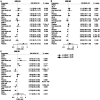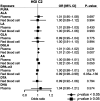This is a preprint.
Circulating polyunsaturated fatty acids and COVID-19: a prospective cohort study and Mendelian randomization analysis
- PMID: 35169810
- PMCID: PMC8845430
- DOI: 10.1101/2022.02.06.22270562
Circulating polyunsaturated fatty acids and COVID-19: a prospective cohort study and Mendelian randomization analysis
Update in
-
Circulating Polyunsaturated Fatty Acids and COVID-19: A Prospective Cohort Study and Mendelian Randomization Analysis.Front Med (Lausanne). 2022 Jun 16;9:923746. doi: 10.3389/fmed.2022.923746. eCollection 2022. Front Med (Lausanne). 2022. PMID: 35783629 Free PMC article.
Abstract
Background: Higher circulating polyunsaturated fatty acids (PUFAs), especially omega-3 ones, have been linked to a better prognosis in patients of coronavirus disease 2019 (COVID-19). However, the effects and causality of pre-infection PUFA levels remain unclear.
Objective: To investigate the observational and causal associations of circulating PUFAs with COVID-19 susceptibility and severity.
Design: We first performed a prospective cohort study in UK Biobank, with 20,626 controls who were tested negative and 4,101 COVID-19 patients, including 970 hospitalized ones. Plasma PUFAs at baseline were measured by nuclear magnetic resonance, including total PUFAs, omega-3 PUFAs, omega-6 PUFAs, docosahexaenoic acid (DHA), linoleic acid (LA), and the omega-6/omega-3 ratio. Moreover, bidirectional two-sample Mendelian randomization (MR) analyses were performed to examine the causal associations of eight individual PUFAs, measured in either plasma or red blood cells, with COVID-19 susceptibility and severity using summary statistics from existing genome-wide association studies.
Results: In the observational association analysis, total PUFAs, omega-3 PUFAs, omega-6 PUFAs, DHA, and LA were associated with a lower risk of severe COVID-19. Omega-3 PUFAs and DHA were also associated with a lower risk of testing positive for COVID-19. The omega-6/omega-3 ratio was positively associated with risks of both susceptibility and severity. The forward MR analysis indicated that arachidonic acid (AA) and docosapentaenoic acid (DPA-n3) might be causally associated with a lower risk of severe COVID-19, with OR (95% CI) per one SD increase in the plasma level as 0.96 (0.94, 0.99) and 0.89 (0.81, 0.99), respectively. The reverse MR analysis did not support any causal effect of COVID-19 on PUFAs.
Conclusions: Our observational analysis supported that higher circulating PUFAs, either omega-3 or omega-6, are protective against severe COVID-19, while omega-3 PUFAs, especially DHA, were also associated with reducing COVID-19 susceptibility. Our MR analysis further supported causal associations of AA and DPA-n3 with a lower risk of severe COVID-19.
Figures



Similar articles
-
Circulating Polyunsaturated Fatty Acids and COVID-19: A Prospective Cohort Study and Mendelian Randomization Analysis.Front Med (Lausanne). 2022 Jun 16;9:923746. doi: 10.3389/fmed.2022.923746. eCollection 2022. Front Med (Lausanne). 2022. PMID: 35783629 Free PMC article.
-
Causal association between polyunsaturated fatty acids and acne: a two-sample Mendelian randomization study.Br J Dermatol. 2025 May 19;192(6):1106-1114. doi: 10.1093/bjd/ljaf052. Br J Dermatol. 2025. PMID: 39936505
-
Plasma polyunsaturated fatty acid concentrations and sleep apnea risk: A two-sample Mendelian randomization study.Front Nutr. 2022 Aug 18;9:956900. doi: 10.3389/fnut.2022.956900. eCollection 2022. Front Nutr. 2022. PMID: 36061896 Free PMC article.
-
A meta-analytic review of polyunsaturated fatty acid compositions in dementia.J Clin Psychiatry. 2012 Sep;73(9):1245-54. doi: 10.4088/JCP.11r07546. Epub 2012 Aug 7. J Clin Psychiatry. 2012. PMID: 22938939 Review.
-
n-3 Polyunsaturated Fatty Acids and Metabolic Syndrome Risk: A Meta-Analysis.Nutrients. 2017 Jul 6;9(7):703. doi: 10.3390/nu9070703. Nutrients. 2017. PMID: 28684692 Free PMC article. Review.
References
-
- World Health Organization. Coronavirus disease 2019 (COVID-19) report. 2021. - PubMed
Publication types
Grants and funding
LinkOut - more resources
Full Text Sources
